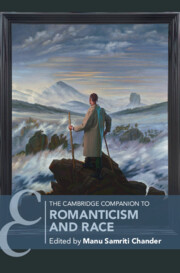Book contents
- The Cambridge Companion to Romanticism and Race
- The Cambridge Companion to Romanticism and Race
- Copyright page
- Contents
- Figures
- Contributors
- Acknowledgments
- Introduction
- Chapter 1 Burke and Kant on Color and Inheritance
- Chapter 2 Breathing Freedom in the Era of the Haitian Revolution
- Chapter 3 Afropessimism, Queer Negativity, and the Limits of Romanticism
- Chapter 4 Samuel Taylor Coleridge’s Racial Imaginary
- Chapter 5 (Not)freedom
- Chapter 6 Disability and Race
- Chapter 7 The Crip Foundations of Romantic Medicine
- Chapter 8 The Voice of Complaint
- Chapter 9 Romantic Manscapes
- Chapter 10 Romantic Poetry and Constructions of Indigeneity
- Chapter 11 Romanticism and the Novel(ty) of Race
- Chapter 12 Reading Race Along the “Bounding Line”
- Chapter 13 The Racecraft of Romantic Stagecraft
- Further Reading
- Index
- Cambridge Companions To Literature
Chapter 5 - (Not)freedom
Published online by Cambridge University Press: 21 November 2024
- The Cambridge Companion to Romanticism and Race
- The Cambridge Companion to Romanticism and Race
- Copyright page
- Contents
- Figures
- Contributors
- Acknowledgments
- Introduction
- Chapter 1 Burke and Kant on Color and Inheritance
- Chapter 2 Breathing Freedom in the Era of the Haitian Revolution
- Chapter 3 Afropessimism, Queer Negativity, and the Limits of Romanticism
- Chapter 4 Samuel Taylor Coleridge’s Racial Imaginary
- Chapter 5 (Not)freedom
- Chapter 6 Disability and Race
- Chapter 7 The Crip Foundations of Romantic Medicine
- Chapter 8 The Voice of Complaint
- Chapter 9 Romantic Manscapes
- Chapter 10 Romantic Poetry and Constructions of Indigeneity
- Chapter 11 Romanticism and the Novel(ty) of Race
- Chapter 12 Reading Race Along the “Bounding Line”
- Chapter 13 The Racecraft of Romantic Stagecraft
- Further Reading
- Index
- Cambridge Companions To Literature
Summary
DJ Lee and Aaron Oforlea’s chapter approaches Coleridge from a different angle, counterposing his vision of freedom with that of the Black Loyalists who supported the English during the American Revolution. Lee and Oforlea’s titular phrase “(not)Freedom” refers to “the fragmentation, resistance, and transgression with which Black Loyalists lived,” which is exemplified in the Loyalists’ linguistic practices. Whether by mimicking the language of white Europeans or by developing a distinctive lingo that infused poetry into the language of transactions, the Loyalists demonstrated a model of freedom – (not)freedom – that was local and transitory, contextually dependent, and always precarious.
Keywords
- Type
- Chapter
- Information
- The Cambridge Companion to Romanticism and Race , pp. 78 - 97Publisher: Cambridge University PressPrint publication year: 2024

